
CSCI 461: Computer Graphics
Middlebury College, Fall 2023
Lecture 04: Scenes
We have always been looking down the z-axis!

By the end of today's lecture, you will be able to:
- set up a camera to look in more general directions,
- use homogeneous coordinates to represent all our 3d transformations with a 4x4 matrix,
- compound rotations, scalings and translations of objects in your scene into a model matrix,
- transform the normal vector of objects in your scene using a normal matrix.


Pointing the camera at some point to "look at."

What is the ray direction then?
How should we place a model in the scene?

How should we place a model in the scene?

How should we place a model in the scene?

How should we place a model in the scene?

How do we animate and/or interact with our model?

Scaling transformation stretches points in each dimension.

Scaling transformation stretches points in each dimension (can be non-uniform).

Rotation matrix rotates vectors by an angle about some axis.

Rotations about the x, y and z-axes.

$$ \mathbf{R}_{\theta,x} = \left[ \begin{array}{ccc} 1 & 0 & 0 \\ 0
& \cos\theta & -\sin\theta \\ 0 & \sin\theta & \phantom{-}\cos\theta
\end{array}\right]$$ $$\mathbf{R}_{\theta,y} = \left[
\begin{array}{ccc} \phantom{-}\cos\theta & 0 & \sin\theta \\ 0 & 1 &
0 \\ -\sin\theta & 0 & \cos\theta \end{array} \right] $$
$$\mathbf{R}_{\theta,z} = \left[ \begin{array}{ccc} \cos\theta &
-\sin\theta & 0 \\ \sin\theta & \phantom{-}\cos\theta & 0 \\ 0 & 0 &
1 \end{array} \right]$$
How to represent a translation (shift) with a matrix?
Homogeneous coordinates is a trick to combine everything into a single matrix.
Main idea: introduce new coordinate equal to 1 for points.Combining transformations: read from right-to-left!
Exercise 1: Transform the top-right corner (dot) of the square.

$$\mathrm{Using:}\quad \mathbf{S} = \left[ \begin{array}{ccc} s & 0 & 0 \\ 0 & 1 & 0 \\ 0 & 0 & 1 \end{array} \right], \quad \mathbf{R} = \left[ \begin{array}{ccc} \phantom{-} \cos\theta & \sin\theta & 0 \\ -\sin\theta & \cos\theta & 0 \\ 0 & 0 & 1 \end{array} \right], \quad \mathbf{T} = \left[ \begin{array}{ccc} 1 & 0 & -p_x \\ 0 & 1 & -p_y \\ 0 & 0 & 1 \end{array} \right]. $$
Exercise 1 solution: $\mathbf{M} = \mathbf{T}^{-1}\mathbf{R}^{-1} \mathbf{S}\mathbf{R}\mathbf{T}$.






Exercise 2: Rotate the Earth about its center.
Click to open the editor.
Transform normals using the inverse-transpose of your transformation.


Summary
- Transform ray direction using change-of-basis $\mathbf{B}$,
- Read transformations from right-to-left.
- Transform normals using inverse-transpose of transformation.
